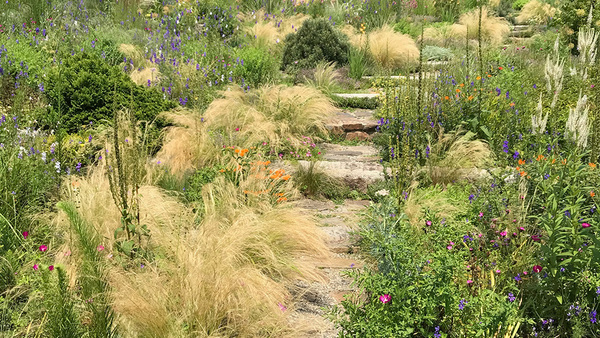
In the Southern Plains, we live among the remnants of what were once vast prairies. The tallgrass prairies in the eastern Southern Plains give way to the short grasslands in the West. Between these, the mixed grass prairies contain elements of both, with the richest species diversity of any North American grassland. From these prairies come an abundance of native flora, including several spectacular grasses for the garden.

The four horsemen
The tallgrass prairie is dominated by four native grasses, the so-called “four horsemen of the prairie.” These include big bluestem (Andropogon gerardii, Zones 3–9), switchgrass (Panicum virgatum, Zones 5–9), little bluestem (Shizachyrium scoparium, Zones 3–9), and Indian grass (Sorghastrum nutans, Zones 4–9). While the first three are common in the nursery trade, Indian grass has not undergone the extensive breeding of its cohorts, though a few cultivars are available, including ‘Indian Steel’ and ‘Thin Man’.
Indian grass is among the earliest warm-season grasses to bloom. The upright foliage stands at around 3 feet tall, adding structure to the garden. Foliage turns from blue-green in the summer to yellow-orange in autumn. The flowering stems rise above the foliage in late summer, reaching 5 to 6 feet tall. The golden panicles provide seed for birds and add interest well into winter.

Top picks from the shortgrass prairie
The shortgrass prairie is dominated by two species: blue grama grass (Bouteloua gracilis, Zones 4–9) and buffalo grass (Buchloe dactyloides syn. Bouteloua dactyloides, Zones 4–8). While both species are used as components of native lawns, blue grama also makes a standout ornamental grass. The variety ‘Blonde Ambition’ brought blue grama into the spotlight, with its fine blue-green foliage and unusual, eyelash-like flowers.
The flowers emerge in midsummer, shifting from chartreuse to golden as the seed heads mature in autumn. This is when they really shine, with a mass of texture and motion that remains in place throughout winter. Several birds feed on the seeds, including sparrows and wrens. Growing 3 feet tall and almost as wide, ‘Blonde Ambition’ blue grama grass also hosts a diversity of butterfly larvae, including that of several skippers.

A native with spectacular fall interest
Perhaps the showiest native prairie grass in autumn is pink muhly grass (Muhlenbergia capillaris, Zones 5–9). This grass transforms from a heap of light green foliage into glowing pink clouds from September through November. Incredibly fine, deep pink seeds float in airy masses above the foliage and look stunning against the sun. Seeds fade to tan in late autumn and remain attractive through winter. The rest of the year, threadlike foliage provides gorgeous texture to the garden, growing in a rounded mound up to 3 feet tall. Plant in drifts for a beautiful display. For information on pruning pink muhly grass, read on here.
All these grasses love full sun and are well adapted to a variety of soil conditions. They have low water needs and actually tend to flop over if given too much water or nutrients. Native grasses are well adapted to our heat, and they tolerate drought. They look fabulous planted among native wildflowers.
For more on plants native to the Southern Plains, check out these articles:
- Harvesting Native Southern Plains Fruits
- Great Native Plants for the Southern Plains
- Best Native Woodies for the Southern Plains
—Kim Toscano is a horticulturalist based in Stillwater, Oklahoma. She previously hosted Oklahoma Gardening, a weekly PBS television program produced by the Oklahoma Cooperative Extension Service.






















Comments
Log in or create an account to post a comment.
Sign up Log in